‘Medfield’ Atom breaks cover — will be in Lenovo and Motorola phones
Jan 11, 2012 — by LinuxDevices Staff — from the LinuxDevices Archive — 1 viewsIntel and Motorola announced a multi-year agreement focused on the development of Atom-powered, Android-based phones and tablets. Meanwhile, Intel showed off an smartphone reference platform and a Lenovo K800 handset that both run Android on the “Medfield” processor — now unveiled as the Atom Z2460 — and third-party benchmarks rated the CPU high marks in performance and power consumption.
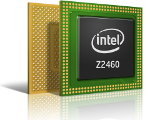 Intel CEO Paul Otellini and Motorola Mobility CEO Sanjay Jha appeared on stage together Jan. 10 at the 2012 Consumer Electronics Show (CES) in Las Vegas, announcing a multi-year, strategic agreement via which Motorola will sell Atom-based smartphones starting in the second half of 2012. Neither financial terms nor duration of the deal were revealed.
Intel CEO Paul Otellini and Motorola Mobility CEO Sanjay Jha appeared on stage together Jan. 10 at the 2012 Consumer Electronics Show (CES) in Las Vegas, announcing a multi-year, strategic agreement via which Motorola will sell Atom-based smartphones starting in the second half of 2012. Neither financial terms nor duration of the deal were revealed.
Motorola will build the devices on Intel's low-power, 32nm "Medfield" processor, which has now been unveiled as the Atom Z2460 (pictured above and detailed later in this story).
Motorola, which is awaiting word from federal regulators on whether or not Google will be allowed to acquire it, will also make Atom-based Android tablets in the future. The companies will collaborate on hardware, software, and services to build mobile gadgets with long battery life, speedy application performance, and better imaging and video capabilities, according to the partners.
The deal follows up on an Intel pact with Google in September to optimize Android for Intel's Atom processor platform, helping the chipmaker in its push into the ARM-dominated smartphone market. Indeed, Otellini said the partnership will help accelerate Intel's move into the mobile market versus ARM.
"We expect the combination of our companies to break new ground and bring the very best of computing capabilities to smartphones and tablets," Otellini told the audience.
Otellini and Jha unveiled their agreement just hours after Intel rival Qualcomm demonstrated its forthcoming ARM-based Snapdragon S4 processor on Microsoft's emerging Windows 8 operating system. Qualcomm CEO Paul Jacobs brought out Nokia CEO Stephen Elop and Sesame Street's Grover to tout the mobile chipsets.
Otellini, whose company is trying to mount a formidable challenge to Qualcomm, wasn't to be outdone by Jacobs. Intel's leader called one partner after another to join him on stage to announce new products.
Lenovo K800 smartphone
One of those guests was Liu Jun, senior vice president and president of mobile Internet and digital home for Lenovo. Jun showed the audience what is likely to be the very first shipping Intel Atom phone.
We say "shipping" because Intel and its partners have shown several Atom phone prototypes and reference platforms in the past, including LG's Moblin Linux-based GW990 in early 2010, Aava Mobile's Virta Android platform for the Atom Z6xx ("Moorestown") chip in early 2010, an Intel smartphone prototype running Android on a "Medfield" Atom processor that was briefly flashed in May 2011, as well as an Intel Atom phone prototype privately demonstrated in December.
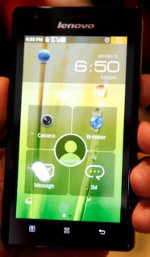 The Android-based Lenovo K800 smartphone has a 4.5-inch, 720p display. Pictured at right from an image taken by Cnet, the K800 supports HSPA+ service thanks to a Intel XMM 6260 baseband chipset announced last February. The K800's Android OS is accompanied by the Lenovo LeOS user interface. Additional features include the ability to hook up the K800 to a TV via HDMI to port media content to the big screen.
The Android-based Lenovo K800 smartphone has a 4.5-inch, 720p display. Pictured at right from an image taken by Cnet, the K800 supports HSPA+ service thanks to a Intel XMM 6260 baseband chipset announced last February. The K800's Android OS is accompanied by the Lenovo LeOS user interface. Additional features include the ability to hook up the K800 to a TV via HDMI to port media content to the big screen.
The U.S. audience may have to wait until Motorola launches its phones to get its mitts on an Intel-powered phone. The K800 smartphone will be available in China in the second quarter and will run on China Unicom's network.
Atom phone reference design outed
After the Lenovo demo, Otellini tapped one of his lieutenants, Michael Bell, general manager of Intel's mobile and communications group, to demonstrate Intel's latest smartphone reference device. The reference design has a 1.6GHz Intel Atom Z2460 processor supported by a four-inch high-resolution LCD touch screen. Bell also showed off the eight-megapixel camera's "burst mode," which allowed him to shoot 15 pictures in less than a second.
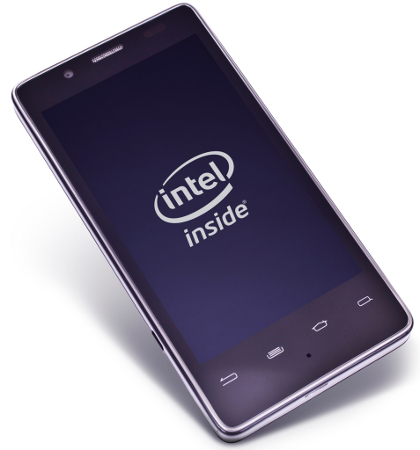
Intel smartphone reference design, running the Atom Z2460
(Click to enlarge)
Bell then listed features including an HDMI port and a near field communication (NFC) component for mobile communications, including payments. The phone was later demonstrated connecting with an NFC-enabled convertible ultrabook to pay for a product from Target.com.
In addition, Intel offered the first public demonstration of the forthcoming 32nm "Clover Trail" SoC for tablets and hybrids, running on Microsoft Windows 8. This chip reportedly offers dual CPU cores instead of the single one featured by Medfield, and we wouldn't be surprised to see the addition of more interfaces (such as PCI Express).
Medfield gets official
The Lenovo K800 is fueled by Intel's long-delayed Medfield processor for smartphones and tablets, which Intel introduced at CES as the Atom Z2460. The low-power processor incorporates a "Penwell" system on chip (SoC) design in a 12 x 12mm package, explains AnandTech in its hands-on demo of a newly unveiled Z2460-based Intel smartphone reference design (see farther below).
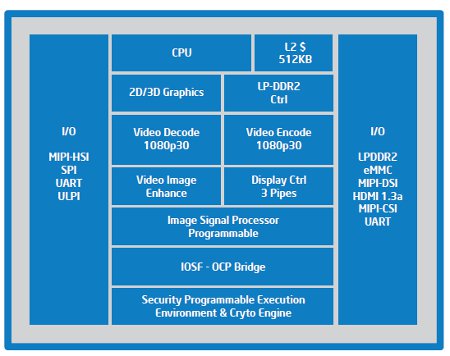
Atom Z2460 architecture
(Click to enlarge)
AnandTech ran some benchmarks and came away impressed with the results, including the leading 1331.5 score on the SunSpider Javascript benchmark (see chart below). "Although running what appears to be a stock Gingerbread browser, Intel's Medfield reference platform posts SunSpider performance better than any other smartphone we've tested — including the Galaxy Nexus running Ice Cream Sandwich," writes Anand Lal Shimpi.
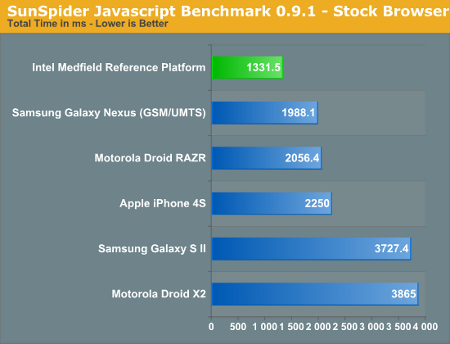
SunSpider Javascript benchmark with Z2460 and leading smartphones
Source: AnandTech
In other words, the Z2460 offers lower than average power consumption compared to ARM-based phones including the HTC Sensation, Motorola Droid 3, iPhone 4S, LG Optimus 2X, and Samsung Galaxy S II. These five phones are shown with the Z2460, presumably in that same order, in the Intel chart below, according to the story.
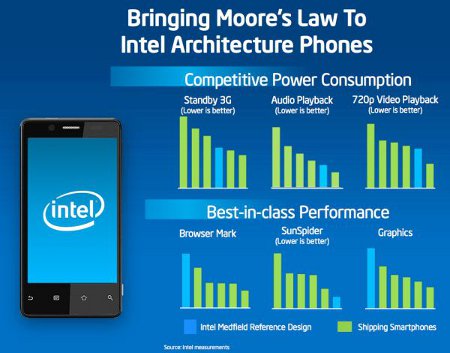
Atom Z2460 (in blue) compared to leading smartphones in Intel benchmarks for power consumption (top) and performance
(Click to enlarge)
Clint Boulton is a writer for eWEEK. Eric Brown contributed the Z2460 segment of this report.
This article was originally published on LinuxDevices.com and has been donated to the open source community by QuinStreet Inc. Please visit LinuxToday.com for up-to-date news and articles about Linux and open source.